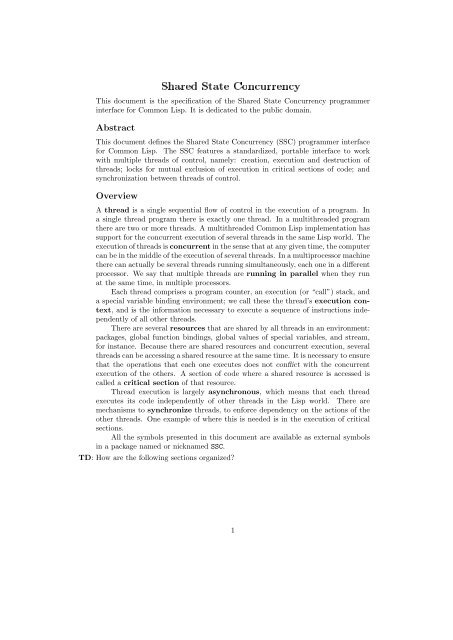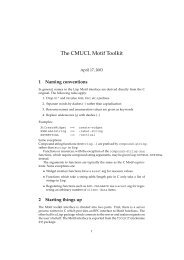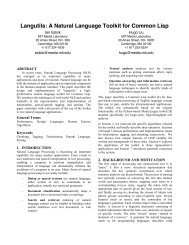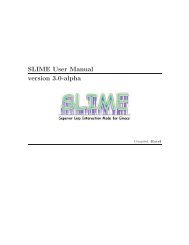Shared State Concurrency - Common Lisp.net
Shared State Concurrency - Common Lisp.net
Shared State Concurrency - Common Lisp.net
You also want an ePaper? Increase the reach of your titles
YUMPU automatically turns print PDFs into web optimized ePapers that Google loves.
<strong>Shared</strong> <strong>State</strong> <strong>Concurrency</strong>This document is the specification of the <strong>Shared</strong> <strong>State</strong> <strong>Concurrency</strong> programmerinterface for <strong>Common</strong> <strong>Lisp</strong>. It is dedicated to the public domain.AbstractThis document defines the <strong>Shared</strong> <strong>State</strong> <strong>Concurrency</strong> (SSC) programmer interfacefor <strong>Common</strong> <strong>Lisp</strong>. The SSC features a standardized, portable interface to workwith multiple threads of control, namely: creation, execution and destruction ofthreads; locks for mutual exclusion of execution in critical sections of code; andsynchronization between threads of control.OverviewA thread is a single sequential flow of control in the execution of a program. Ina single thread program there is exactly one thread. In a multithreaded programthere are two or more threads. A multithreaded <strong>Common</strong> <strong>Lisp</strong> implementation hassupport for the concurrent execution of several threads in the same <strong>Lisp</strong> world. Theexecution of threads is concurrent in the sense that at any given time, the computercan be in the middle of the execution of several threads. In a multiprocessor machi<strong>net</strong>here can actually be several threads running simultaneously, each one in a differentprocessor. We say that multiple threads are running in parallel when they runat the same time, in multiple processors.Each thread comprises a program counter, an execution (or “call”) stack, anda special variable binding environment; we call these the thread’s execution context,and is the information necessary to execute a sequence of instructions independentlyof all other threads.There are several resources that are shared by all threads in an environment:packages, global function bindings, global values of special variables, and stream,for instance. Because there are shared resources and concurrent execution, severalthreads can be accessing a shared resource at the same time. It is necessary to ensurethat the operations that each one executes does not conflict with the concurrentexecution of the others. A section of code where a shared resource is accessed iscalled a critical section of that resource.Thread execution is largely asynchronous, which means that each threadexecutes its code independently of other threads in the <strong>Lisp</strong> world. There aremechanisms to synchronize threads, to enforce dependency on the actions of theother threads. One example of where this is needed is in the execution of criticalsections.All the symbols presented in this document are available as external symbolsin a package named or nicknamed SSC.TD: How are the following sections organized?1
About the argumentsIn the following, it must be observed that parameters named• thread must be thread objects;• lock must be mutual exclustion lock objects;• rwlock must be read/write lock objects;• condvar must be condition variable objects;• semaphore must be semaphore objects;• barrier must be barrier objects;• name must be either strings or nil;• timeout must be non-negative real numbers.It is an error, that must be reported by the implementation, if some argument doesnot respect these rules.Additionally, in macros, the parameter named body can be empty.2
ThreadsA thread is useful only if it used to execute some code. The code that a thread executesis given by a parameterless function; that functions is the thread’s associatedfunction.make-thread function &key name &allow-other-keysThis creates and returns a new thread and starts execution of function in it.FunctionAt any instant, a thread can be in one of four states: running, ready, blocked,or dead. A running thread is a thread that is currently running. There may beat most one thread running in one processor. This means that in a single processormachine, there may be at most one running thread; in a multiprocessor machine,there may be more than one.A ready thread is a thread that can run, but it is not currently runningbecause it is waiting for a processor. A thread is in this state if it has just startedor become unblocked, or because it was preempted by another thread.A blocked thread is a thread that cannot run, because it is “waiting forresources.” This may happen to a thread when it is waiting to acquire a lock orwaiting for a condition variable, for example, or when it is waiting for some I/Ooperation.A dead thread is a thread that has already exited its associated function.A thread may alternate between ready and running states at any instant. Thisis controlled by the scheduler, and is more-or-less independent from the thread (ifwe ignore some hints, like yield-processor).TD: Complete the explanation.A thread that is not dead is alive. After a thread becomes dead, it cannot bemade alive again.thread-alive-p threadFunctionThis is a predicate that is true if thread is alive.A thread is alive from the momentit is created (just before make-thread returns) until sometime after it terminatesrunning its associated function.It is possible to terminate the execution of thread before it’s associated functionreturns.kill-thread threadFunctionThis terminates the execution of the associated function of thread, if it is alive. Ifthread is already dead, this function does nothing.A thread may not terminate immediately on a call to kill-thread, i.e., itis not guaranteed that thread has terminated when kill-thread returns. On theother hand, kill-thread does not return if it is called with the current thread.threadp objectThis is a predicate that is true if object is a thread.thread-name threadThis returns the name of thread.3FunctionFunction
current-threadThis returns the object for the current thread.alive-threadsFunctionFunctionThis returns a list of threads that are currently alive. One thread that is certain tobe a member of (alive-threads) is (current-thread).yield-processorFunctionThis is an hint to the scheduler that this is a good time to change state of the currentthread from running to ready and allow other thread to run in the processor thatthe current thread is running.TD: How does the function cl:sleep behave?TD: What about the scheduler?TD: How does the garbage collector behaves in relation to unreachable and blockedthreads?(make-thread #’(lambda ()(let ((m (make-lock)))(acquire-lock m)(condvar-wait (make-condvar m)))))Each thread has a priority, a number between −5 and +5, that is an indicationto the scheduler of how important it is that the thread be chosen to runwhen there are several threads ready and not enough CPUs for them all. Largerpriority numbers represent more important threads. This can be ignored by theimplementation.thread-priority threadFunctionThis returns the priority of thread; it is a value between −5 and +5. This can bechanged with setf. The argument for the setf form must be an integer between−5 and +5.Note that the value you specify with setf might not be the one you get back:in an implementation that does not support priorities, thread-priority mightalways return 0, for example.4
Mutual exclusion locksOne way to protect a thread from interference from other threads when it is runningin a critical region for some resource is to disallow any other thread to enter a criticalregion for the same resource.A mutual exclusion lock, or simply lock, is an device that supports sharingof resources common to several threads by mutual exclusion. They protect criticalregions of code where only one thread at a time can be running. It is thus guaranteedthat there are no concurrent accesses to the resource.A lock is an object that a thread can acquire, in order to claim exclusiveaccess to a shared resource. We then say that the lock is owned by the thread thatacquires it. A lock not owned by any thread is unowned. After the thread is donewith the resource, it releases the lock. An attempt to acquire a lock only succeedsif the lock is unowned. When a thread attempts to acquire a owned lock, it blocksuntil the lock is released by other thread.A lock is fair when the order by which threads manage to acquire it is thesame as the temporal order that the request is done. Although implementations areencouraged to implement fair locks, this specification does not require that they do.There are two major kinds of locks: recursive and non-recursive. A recursivelock is one that can be recursively locked by any thread. When a thread recursivelyacquires the lock, it must be released an equal number of times to really release thelock. A non-recursive lock is one that does not allow recursive locking: if a threadtries to acquire a lock that it is already owned by itself the thread either deadlocksor the acquiring fails.make-lock &key name (kind :errorcheck) &allow-other-keys FunctionThis creates and returns a new, unowned lock. The argument kind can be one of:errorcheck, :no-errorcheck, or recursive; it is an error if it is any other object.acquire-lock lockFunctionThis acquires lock. If lock is already owned by other thread, then the current threadblocks until lock becomes unowned. If lock is already owned by the current thread,what happens depends on the kind of lock. In a recursive lock, the lock is ‘reacquired’,and it must be released an equal number of times; in a :errorchecklock, a condition lock-deadlock-error is signaled; in a :no-errorcheck lock thecurrent thread deadlocks. This function returns an unspecified value.try-acquire-lock lockFunctionThis tries to acquire lock. If lock is unowned, it acquires lock and returns t; otherwise,it returns nil. In a recursive lock that is already owned by the current thread,this function succeeds in re-acquiring the lock and it returns t. In a non-recursivelock that is owned this function returns nil.timed-acquire-lock lock timeoutFunctionThis tries to acquire lock until it manages to acquire it or until timeout secondselapse, whichever comes first. If it manages to acquire the lock, the function returnst; otherwise it returns nil.The accurrecy of timeout is unspecified, but implementations are encouragedto keep it under one second. One possible, although not the best, implementationof this function is5
(defun timed-acquire-lock (lock timeout)(loop until (try-acquire-lock lock)until (
Read/Write LockA read/write lock is a lock that protects access to shared resources, like a mutualexclusion lock does, but that distinguishes between threads that want to modifydata and threads that merely want to read them. While a mutual exclusion lockdoes not allow concurrent access to data, a read/write lock allows it as long as no<strong>net</strong>he threads need to change the data.A read/write lock has a fairness property, which is its behavior when thereare reader and writer threads trying to lock the read/write lock. A fair or unbiasedlock is one in which readers and writers have access to the lock in the order thatthat they ask for it: readers wait for earlier writers; writers wait for earlier readersand writers. A reader biased lock is one in which preference is given to thereaders, allowing a new readers to join a group of current readers even if thereare writers waiting. A reader biased lock minimizes the delay for readers at theexpense of readers reading possible outdated data. A writer biased lock is one inwhich preference is given to the writers, making new readers wait for any currentor waiting writer. A writer biased lock ensures that updates are seen as soon aspossible at the expense of less throughput of readers.make-rwlock &key name (fairness :fair) &allow-other-keysFunctionCreates and returns a new, unlocked read/write lock. The argument fairness canbe one of :fair, :read-bias, or :write-bias. This argument is an hint to theimplementation, and can be ignored. It hints if the lock should be fair, reader biasedor writer biased. It is an error it fairness is any other object.acquire-rwlock rwlock access-kindFunctionThis locks rwlock for the current thread. The argument access-kind can by either:read or :write; it is an error if it is any other object. It specifies which kind ofoperation the thread intends to do in the resource. If the lock cannot be locked,the current thread blocks until it can. The function returns an unspecified value.If the current thread has already locked the read/write lock, it deadlocks.try-acquire-rwlock rwlock access-kindFunctionThis is similar to lock-rwlock but instead of blocking the current thread if rwlockis not available, it returns nil. If it succeeds in locking rwlock, it returns t.timed-acquire-rwlock rwlock access-kind timeoutFunctionThis tries to acquire rwlock until it manages to acquire it or until timeout secondselapse, whichever comes first. If it manages to acquire the lock, the functionreturns t; otherwise it returns nil.release-rwlock rwlockFunctionThis unlocks rwlock. It is an error if the current thread does not own rwlock. Itreturns an unspecified value.with-rwlock (rwlock access-kind) &body bodyThis executes the body of the macro with rwlock locked.rwlockp objectThis is a predicate that is true if object is a read/write lock.7MacroFunction
wlock-name rwlockReturns the name of rwlock.Function8
Condition VariablesA condition variable is a synchronization mechanism used by threads to wait for andsignal changes in the state of shared data. Two operations are definied: a threadcan wait on a condition variable, blocking itself until a change in some shared datahappens; and a thread can signal a condition variable, unblocking some thread thatis waiting on it. Usually, a wait is done by a thread that wants to change the shareddata, and a signal is done by a thread that has just changed the data.A condition variable is always connected to the change of state of some shareddata. Because of this, it has an associated lock that is used to protected thecritical sections of those shared data.make-condvar lock &key name &allow-other-keysFunctionThis creates and returns a new condition variable with lock as its associated lock.wait-condvar condvarFunctionThis atomically unlocks condvar’s associated lock and blocks the current threadon the condition variable condvar. Before returning, after the current thread isunblocked, the function relocks condvar’s associated lock. This function returns anunspecified value. If this function is called by a thread that does not own condvar’sassociated lock, a lock-not-locked-error condition is signaled.wait-condvar/timeout condvar timeoutFunctionThis is similar to wait-condvar, but if the condition variable is not signaled beforetimeout seconds pass, this function returns :timeout. It returns an unspecifiedvalue, different from :timeout, if timeout seconds have not yet passed.signal-condvar condvar &key allpFunctionThis signals that something changed in the state of the shared resource protectedby the lock associated to condvar. This means that if some threads are waitingfor this condition, then one (if allp is nil) or all (if allp is not nil) of the blockedthreads should wake up. If there are no threads blocked on condvar then this hasno effect. This function returns an unspecified value. If this function is called bya thread that does not own condvar’s associated lock, a lock-not-locked-errorcondition is signaled.A spurious wakeup is the unblocking of a thread waiting on a conditionvariable that happens without other thread signaling the condition variable. Toallow greater flexibility, implementations are allowed to have this behavior. Becauseof this, the condition variable’s predicate must always be checked.condvar-lock condvarFunctionThis returns the mutual exclusion lock associated with condvar. It is an error ifcondvar is not a condition variable.condvarp objectThis is a predicate that is true if object is a condition variable.condvar-name condvarThis return the name of condvar.An idiomatic use of of the operations on a condition variable is9FunctionFunction
(defun enqueue (queue element)(with-lock ((condvar-lock (queue-condvar queue)))(%enqueue queue element)(when (queue-was-empty-p queue)(signal-condvar (queue-condvar queue)))))(defun dequeue (queue)(with-lock ((condvar-lock (queue-condvar queue)))(loop while (queue-empty queue)do (wait-condvar (queue-condvar queue)))(%dequeue queue)))10
SemaphoresSemaphores are synchronization objects with an internal integer counter. Two operationsare defined in a semaphore and both act on the semaphore’s internal counter:the down operation decreases the counter value by 1 and the up operation increasesit by 1. In addiction, and depending on the value of the internal counter,the current thread can block during a down operation or it can unblock a blockedthread during an up operation.make-semaphore value &key name &allow-other-keysFunctionThis creates and returns a new semaphore with value as the initial value of itsinternal counter. It is an error if value is not an integer.down-semaphore semaphoreFunctionThis checks the semaphore’s internal counter. If the counter is zero, the currentthread blocks until some other thread does an up operation in the semaphore,thus increasing the counter. When the counter is greater than zero, the functiondecreases it by 1 and returns the new value.try-down-semaphore semaphoreFunctionThis checks the semaphore’s internal counter and, if it is greater than zero, decreasesit by 1 and returns the new value. If the internal counter is not greater than zero,the function returns nil, not changing the semaphore in any way.This function is similar to down-semaphore, but where the down-semaphorewould block the current thread, this function returns nil instead.timed-down-semaphore semaphore timeoutFunctionThis tries to do a down operation on semaphore until it manages to do it or untiltimeout seconds elapse, whichever comes first. If it manages to do the down operation,the function returns the value new value of the semaphore; otherwise itreturns nil.up-semaphore semaphoreFunctionThis functions increases the semaphore’s internal counter value by 1 and returnsthe new value. This can have the side effect of waking a thread that is blocked indown-semaphore.with-semaphore (semaphore) &body bodyMacroThis does a down operation on semaphore, executes body, and then does an upoperation on the semaphore. The up operation is done even if body exits non-locally.It returns whatever results from evaluating body.semaphorep objectThis is a predicate that is true if object is a semaphore.semaphore-name semaphoreThis returns the name of semaphore.FunctionFunction11
BarriersA Barrier, is a synchronization mechanism used by a fixed number of threads. Aseach thread reaches the barrier it blocks. When the last thread reach the barrier, allblocked threads are unblocked and the barrier is reset to be used in a new iteration.make-barrier count &key name &allow-other-keysFunctionThis creates and returns a barrier with count participant threads. It is an error ifcount is not a positive integer.pass-barrier barrierFunctionThis blocks the current thread until the required number of threads have calledpass-barrier on barrier. When that occurs, two things happen: the barrier is resetto be used again, in a new iteration; all threads that were blocked are unblockedand this function returns t in one of the threads and nil in all the others.pass-barrier/timeout barrier timeoutFunctionThis is similar to pass-barrier, but it returns :timeout if timeout seconds passand some of the other participant threads have not passed yet.barrierp objectThis is a predicate that is true if object is a cyclic barrier.barrier-name barrierFunctionFunctionThis return the name of barrier. The name of a barrier can be altered with setf.12
Thread-mailboxFIX: Isn’t there a better term than thread-mailbox?Any thread can send messages to any thread. A message has a sender, whichis the thread that sends the message and a receiver, which is the recipient thread.The message itself can be any lisp object. Each thread has a thread-mailbox,which stores the messages sent to the thread. The messages are stored in a queue,in the order that they were sent. The first message in a thread-mailbox is theoldest message that has not it been received by the thread; it is the first messagein the queue . The last message in a thread-mailbox is the newest message; it isthe last message in the queue.thread-send thread messageFunctionThis stores message as the last message in thread’s thread-mailbox. It returns anunspecified value.If thread is dead, then a message-delivery-error condition is signaled in thethread that called thread-send.thread-receiveFunctionThis returns the first message in the current thread’s thread-mailbox. If no messageis available, the current thread blocks until one is available.thread-try-receiveFunctionThis is similar to thread-receive and it has the same effect in the current thread’sthread-mailbox if it is not empty. When no message is available, this function doesnot block the current thread. It returns two values: if a message is available , itreturns (values (thread-receive) t); if a message is not available, it returns(values nil nil).13















